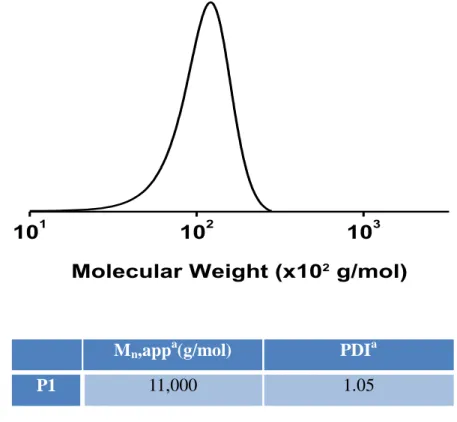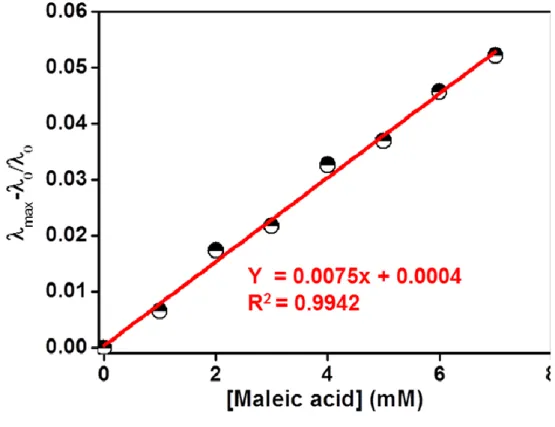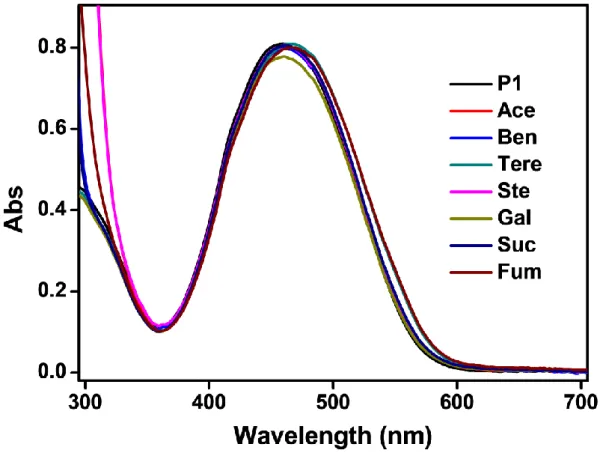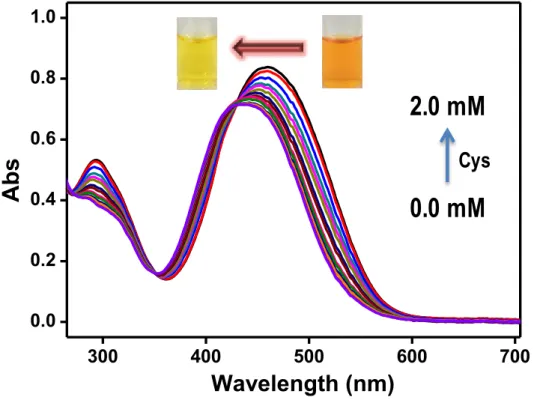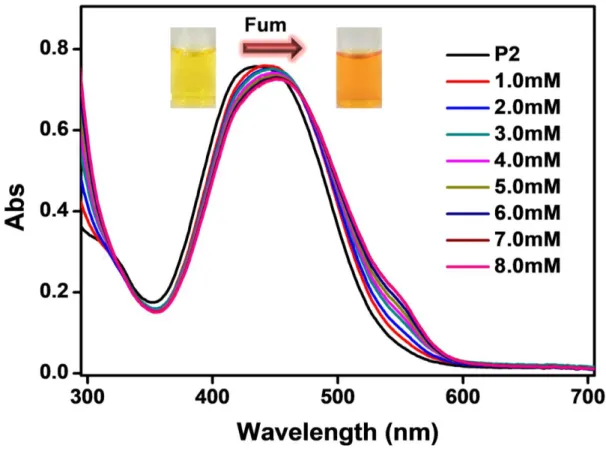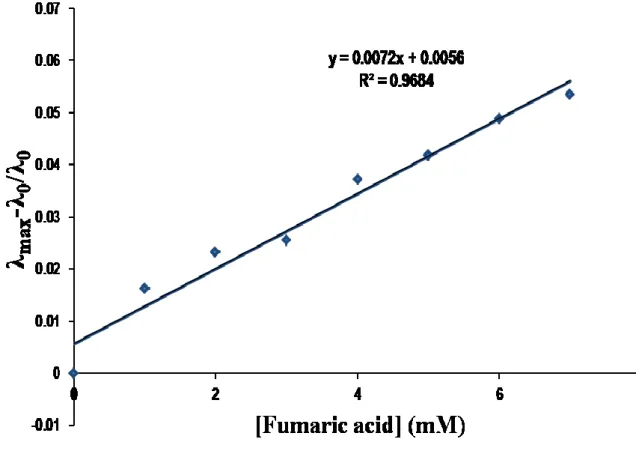Water-soluble copolymers were prepared by reversible addition-fragmentation transfer polymerization (RAFT), which is used to successfully distinguish maleic acid from the structurally similar fumaric acid. In the case of P1 (aldehyde group), maleic acid and fumaric acid, which contain other carboxylic groups, enabled selective colorimetric detection. In the case of P2 (thiazolidine ring), maleic acid and fumaric acid did not allow selective detection, but distinguished from other carboxylic acids.
These results were influenced by the magnitude of the acid dissociation constant of the polymer probe. 1 Among the various carboxylic acids, maleic acid and fumaric acid are the most studied as biomolecules due to its association with various research fields such as food processing, medicinal chemistry and polymer synthesis. 2, 3 Maleic acid used food additives plays an important role as an inhibitor of Curbs cycles. On the other hand, fumaric acid derivatives have been used to treat patients with multiple sclerosis or psoriasis.4, 5 Despite its biological use, severe accumulation of maleic acid and fumaric acid in the human body results in severe heart disease. 6 Therefore, it is important to develop reliable and economically viable analytical methods for the detection of these acids.
However, this probe has a similar colorimetric response to phthalates and thus lacks selectivity.18 Similarly, Upendar and co-workers reported reversible thiourea-based probes for the detection of maleic acid and fumaric acid, but did not distinguish between these two isomers by optical reactions. 19 Recently, Samanta and co-workers synthesized Schiff base-derived probes for colorimetric and fluorescence measurements of maleic acid and fumaric acid. Thus, we designed water-soluble azo-based polymer probes (P1~P3) bearing different pendant –R groups (i.e., aldehydes, thiazolidines, and nitriles) to discriminate between maleic acid and fumaric acid in pure aqueous medium at physiological pH. The fumaric acid supplied by TCI was of the highest purity and was used as received.
1 H NMR spectra of the polymer solutions were recorded on a Bruker Avance 300 MHz, and the data was collected at 298 K using CDCl 3 as solvent.
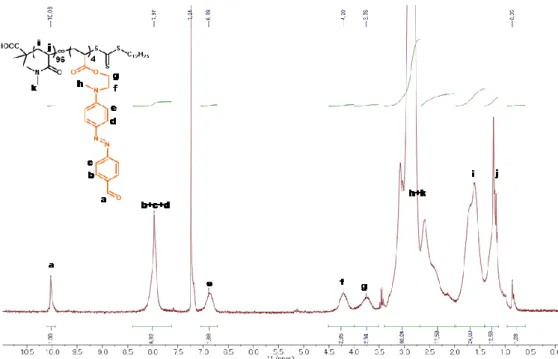
Synthesis and characterization of P1
Selectivity bar diagram and photographs of aqueous solution of (b) P1, (d) P2 and (f) P3 versus 7 different carboxylic acids. λ max plot (λ max = λ0 – λx, λx is the maximum wavelength with the addition of 8 Mm of each different carboxylic acid, λ0 is the absorption maximum of P1, P2 and P3).
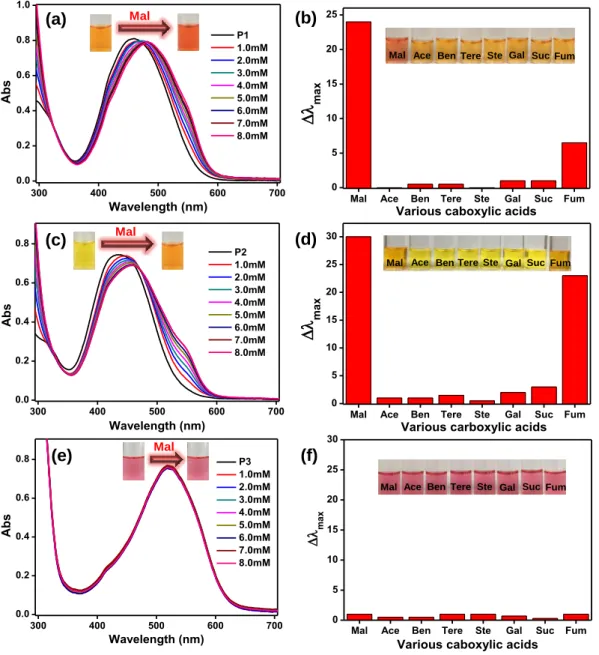
Selective colorimetric sensing and discrimination efficiency or inefficiency of maleic acid using P1~P3
P1 has been reported to be an excellent candidate for the selective colorimetric detection of cysteine (compared to that of the other amino acids) in pure water. The blue shift of the absorption spectra of P1 indicated that the intramolecular charge transfer effect (ICT) of azobenzene aldehyde units of P1 was interrupted by the formation of a thiazolidine ring with cysteine.21-25.
Wavelength (nm)
In view of the differential detection of maleic acid by the functional groups of each polymer, it was hypothesized that the protonation of the β-nitrogen atom of the azochromophore by the carboxylic acid may be an important factor (Scheme 2). Protonation of the β-nitrogen atoms of the azo chromophore (azonium form) leads to an increase in the negative mesomeric (-M) effect of the chromophore, which in turn strengthens the push-pull effect (Scheme 3). As a result, the absorption maximum of the polymeric probes was red-shifted in the presence of carboxylic acids.27.
Compare to push-pull effects by negative mesomeric (–M) effect of chromophore
Here, AHA and AA– represent the absorbance of acidic and basic solutions of the polymeric probe at the absorption maximum, respectively. P1 was measured to be 2.84 (Figure 12a) higher than maleic acid (1.9) but lower than other carboxylic acids including fumaric acid (3.1). As a result, the β-nitrogen atom of the azo chromophore of P1 was selectively protonated by maleic acid, and the difference between maleic acid and fumaric acid provided by P1 was observed.
On the other hand, the pKa value of P2 was calculated to be 3.64 (Figure 12b), which is higher than maleic acid and fumaric acid, but lower than other carboxylic acids. This means that the β-nitrogen atom of the azochromophore of P2 was difficult to distinguish between maleic acid and fumaric acid. Therefore, protonation of the β-nitrogen atoms in the azo chromophore of P3 was not sensed by any of the other carboxylic acids, including maleic acid and fumaric acid.
P1 can acquire various azo-containing –R groups (aldehydes, thiazolidines, and nitriles) for selective colorimetric detection of maleic acid and/or discrimination between maleic acid and its structurally similar fumaric acid. Depending on the -R group (aldehyde, thiazolidine or nitrile), the degree of protonation of the β-nitrogen atom could be controlled. The protons of β-nitrogen atoms of azochromophores with pKa and maleic acid (1.9), fumaric acid (3.1), and other carboxylic acids of each polymer are considered to be important factors depending on the functional groups of each polymer.
아조 발색단의 양성자화 정도는 프로브와 카르복실산의 산해리상수(pKa) 값에 따라 달라지며, 이러한 pKa는 선택적 분석물질 검출 메커니즘을 이해하는 데 중요한 매개변수가 될 수 있습니다. 사만다, S.; 카르, C.; Das, G., 용액 및 식품 첨가물에서 말레산을 실시간으로 검출하여 기하 이성질체(말레산 대 푸마르산)의 비색 및 형광 분석 식별. 다양한 카르복실산 중에서 말레산과 푸마르산은 식품 가공, 의학, 화학, 고분자 합성 등 다양한 연구 분야와의 관련성으로 인해 가장 많이 연구되는 생체분자입니다.
말레산은 사료 첨가제에 사용되며 커브스 사이클의 억제제로서 중요한 역할을 합니다. 또한, 푸마르산은 다발성 경화증이나 건선 환자를 치료하는 데 사용되었습니다. 분석방법 중 화학반응을 기반으로 실시간 검출이 가능한 유기물 기반 화학센서가 개발됐다.
그들은 높은 감도와 선택성을 가지고 있습니다. 특히, 비색법을 이용한 화학센서는 검출 과정을 육안으로 쉽게 관찰할 수 있어 실용적이다.

